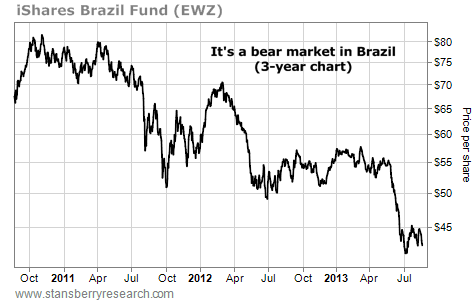| Home | About Us | Resources | Archive | Free Reports | Market Window |
|
Editor's note: Today, we continue sharing some of the most popular research we've ever published... It covers an elite class of stocks we truly believe every individual investor should own. Yesterday, we explained which clues tell you you're looking at one of the world's best businesses. Below, we show you how steady, high rates of dividend growth from these businesses can lead to double-digit annual returns...
A Hidden Source of Double-Digit Annual ReturnsBy
Wednesday, August 21, 2013
If you're looking to earn 10% or more on your portfolio year after year, chances are, you're looking in the wrong place...
Chances are, you're buying risky, overpriced, "high growth" stocks that have a good story. Or you're buying risky, leveraged, "high income" stocks. Either way, over the long term, you're more likely to lose money than make it.
Most companies that are growing fast command much too high a premium in the market. If the growth comes in below expectations, you lose big. And most companies that pay double-digit yields are vulnerable to even small potholes in the credit or commodity markets.
Here's the thing: You're missing one of the world's greatest sources of double-digit annual returns. It's right under everyone's nose. But hardly anyone sees it.
Let me show you what I mean...
Over the long term, big dividend growth usually comes with big share-price growth...
Think about it... A higher dividend makes the shares more valuable.
Think about a company that pays $0.50 in annual dividends. If the share price is $20, that's a 2.5% yield. Now let's say the company increases its dividend payout to $0.55. For the yield to stay at 2.5%, the share price would have to climb to $22.
So all things being equal, a 10% increase in the dividend payout will translate into a 10% increase in share price. (Adding in the original dividend, you've made 12.5% in a year.)
I've found that over the long term, companies that regularly make large increases to their dividends see large long-term share-price growth as well.
Take Wal-Mart, for example. Since March 1974, the retail giant's split-adjusted dividend has grown about 24.2% a year, and its split-adjusted share price has grown about 21% a year. That's incredible.
Of course, the math doesn't always work out so perfectly. I first recommended Wal-Mart to my readers in 2006. Over that time, its share price is up 53%. Its dividend is up an incredible 180%.
Even when the numbers don't line up exactly, big dividend growth and big share-price growth move together.
McDonald's split-adjusted dividend has grown about 21% per year since 1976. Its split-adjusted share price has grown about 14% a year. Yes, the McDonald's numbers are different... But they're both enormous, especially when you stop to realize you're talking about 37 years of compounding.
Medical-equipment manufacturer Becton-Dickinson is another example. Becton-Dickinson's split-adjusted dividend has grown about 13% a year since 1992. Its split-adjusted share price has grown about 14% a year.
The point isn't that share price and dividend growth are exactly the same over time. It's that when one of them grows a lot over the long term, the other grows a lot, too.
When dividends rise decade after decade at inflation-beating rates, you can expect the value of that growth to be reflected in the share price.
In other words, when a high-quality company – like Wal-Mart, McDonald's, or Becton-Dickinson – raises its dividends by double digits every year, you can expect to average double-digit returns over the long term. And you'll do it without the risks you take on with almost every other strategy.
Most investors look for companies with high current yields or high rates of revenue growth. I look for steady, high rates of dividend growth.
For the safest double-digit long-term returns, you should, too.
Good investing,
Dan Ferris
Further Reading:
One question Porter Stansberry likes to ask financial pros is: "What do you tell your mother and father to do with their money?" The nearly unanimous answer shouldn't surprise you: "I tell my parents to invest for dividends in the biggest and most stable companies we can find." Find out why you should move your investments into the world's best dividend-paying companies here.
The world's best dividend-paying companies "have the power to protect against inflation because they can grow your investment faster than inflation erodes it," Dr. David 'Doc' Eifrig writes. These businesses grow their dividends every year because they hold "pricing power and have brand loyalty." That's why Doc says these businesses are a better inflation hedge than gold. Get all the details here.
Market NotesSOME GOOD ADVICE ON BRAZIL Yesterday, we checked out some of the best-performing stocks. But how about some of the worst? To find them, we head to Brazil...
Back in early 2011, we used Brazilian stocks to issue this timely warning on the commodity market. Brazil is a popular destination for investors who want exposure to commodities. It's a major producer of soybeans, cattle, corn, coffee, sugar, and iron ore. Much of this production heads to China, Brazil's largest trading partner.
Since our warning, the Chinese economy has slowed... and Brazilian stocks have been crushed. For details, we consult the major Brazilian investment fund (EWZ).
As we noted yesterday, we monitor a list of more than 70 investment funds. The list covers every major country, sector, commodity, and currency. Right now, the Brazil fund "boasts" the worst 12-month return (-21%) of our country funds. When interest toward commodities sinks, so do Brazilian stocks.
 |
In The Daily Crux
Recent Articles
|


